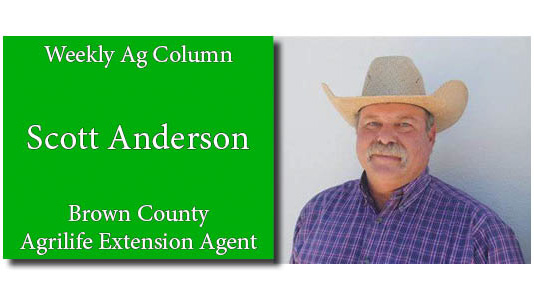
Thursday, June 29th is the date of the Multi-County Range/Brush program. This program is being conducted by the Texas A&M AgriLife Extension Service. It will be held at the Adams Street Community Center located at 511 East Baker Brownwood, TX. Registration will begin at 8:30am and the program at 9:00am.
Brush encroachment continues to be an expensive problem to deal with. If left unchecked, these pasture invaders reduce grazable acres for livestock and can make areas undesirable for some wildlife. The current drought has not impeded brush encroachment.
Speakers and topics for the June 29th program include:
Dr. Morgan Treadwell – Extension Range Specialist, San Angelo
Mechanical Brush Control
Greg Wilson – Extension Entomologist, San Angelo
Range/Pasture Insect Pest Management
Billy Campbell – Bayer Environmental Science Range & Pasture Specialist
Range/Pasture Herbicides
Scott Nolte – Extension Weed Specialist, College Station
Reducing Pesticide Drift
Scott Anderson – CEA-AG/NR
Pesticide Laws and Regulations
There will be a $50 registration fee payable at the door. A catered meal is included. Pre-registration is required by June 21, 2023.
This program has been approved for 5 CEUs from the Texas Department of Agriculture for TDA licensed pesticide applicators. 1 laws and regulation, 2 integrated pest management, 1 drift minimization, and 1 general. This program is open to anyone interested.
To pre-register or for more information contact the Brown County Extension Office at 325-646-0386.
***
PASTURE GRASSES RELY ON HEALTHY ROOTS
The productivity of a perennial grass pasture is quite literally anchored in its root system. Roots are responsible for water and nutrient uptake, transporting these materials to other plant parts, and supporting aboveground biomass. Roots are also the home base for symbiotic relationships between plants and microorganisms, and they serve as a storage structure for energy produced during photosynthesis.
While strong roots foster resilient stands, a feeble foundation can compromise grass growth on the surface. For example, shallow roots have a reduced capacity for water and nutrient uptake. Furthermore, forage regrowth after cutting hay or grazing livestock may be delayed if root systems are weak.
Root growth and vegetative growth occur independent of one another; however, each type of growth is critical for its counterpart. When grass species are cut or grazed, defoliated plants rely on energy stored in their roots to fuel new growth. As nutrients are mobilized from root to shoot, plants prioritize vegetative growth. Then as new leaves develop and begin to photosynthesize, energy is redirected belowground, and root growth commences again.
Some perennial warm-season grass species like bermudagrass store energy in underground modified stems called rhizomes. Like root reserves, rhizome reserves are depleted when forage is defoliated.
Although the speed of vegetative growth and root growth depends on several factors like water availability, fertilization, and weather conditions, two of the most important factors are the intensity and frequency at which grass is cut or grazed. When too much of a plant is removed and/or forages do not have enough time to accumulate and store energy in their roots between harvests, root growth will slow down and possibly stop. This ultimately impairs the condition of a grass forage stand.
Running on empty
Aukema compares root reserves to the gas tank in a car. Regardless of fuel efficiency or tank size, a vehicle will eventually run out of gas if the driver never stops to fill up. Likewise, plants will suffer if they don’t have the chance to replenish their root reserves.
To continue the analogy, drivers with shorter commutes will have more miles until empty at the end of the workday. The same goes for root reserves in that they will have more energy available for growth when less aboveground biomass is removed. This concept was demonstrated in a research study by Franklin Crider, a scientist with the USDA Soil Conservation Service, in the 1950s.
When less than 40% of the tops were trimmed, root growth did not slow down compared to before cutting.”
Slowed or ceased root growth is especially detrimental during drought when water is located deeper in the soil profile. These shallow root systems can also curtail nutrient uptake, which can lead to more nitrate leaching and lower fertilization efficiency.
Refilling the tank
Giving plants a longer rest period between harvests may also improve root growth and function.
Root growth still stopped when forage was clipped to the lowest levels; however, it eventually resumed as forage had more time to recover. Continuous grazing or cutting of pasture forages too short and without rest will stop roots from growing and likely eventually lead to decline of that pasture.
Controlling weeds and preventing competition with unwanted species will help forage grow stronger above and below the surface, too.